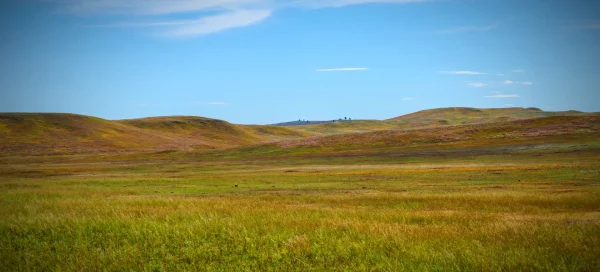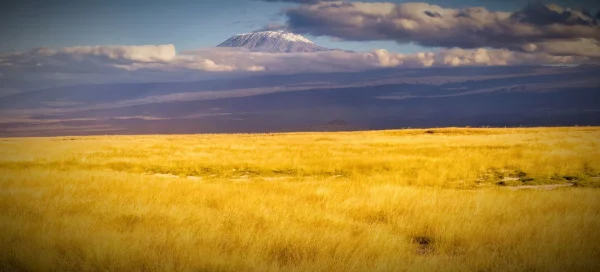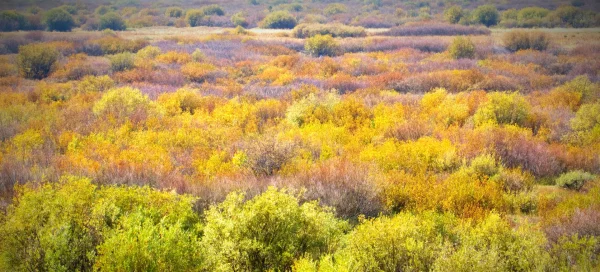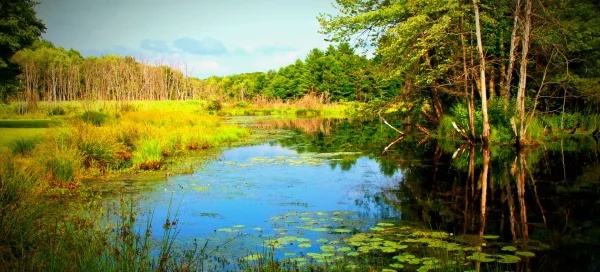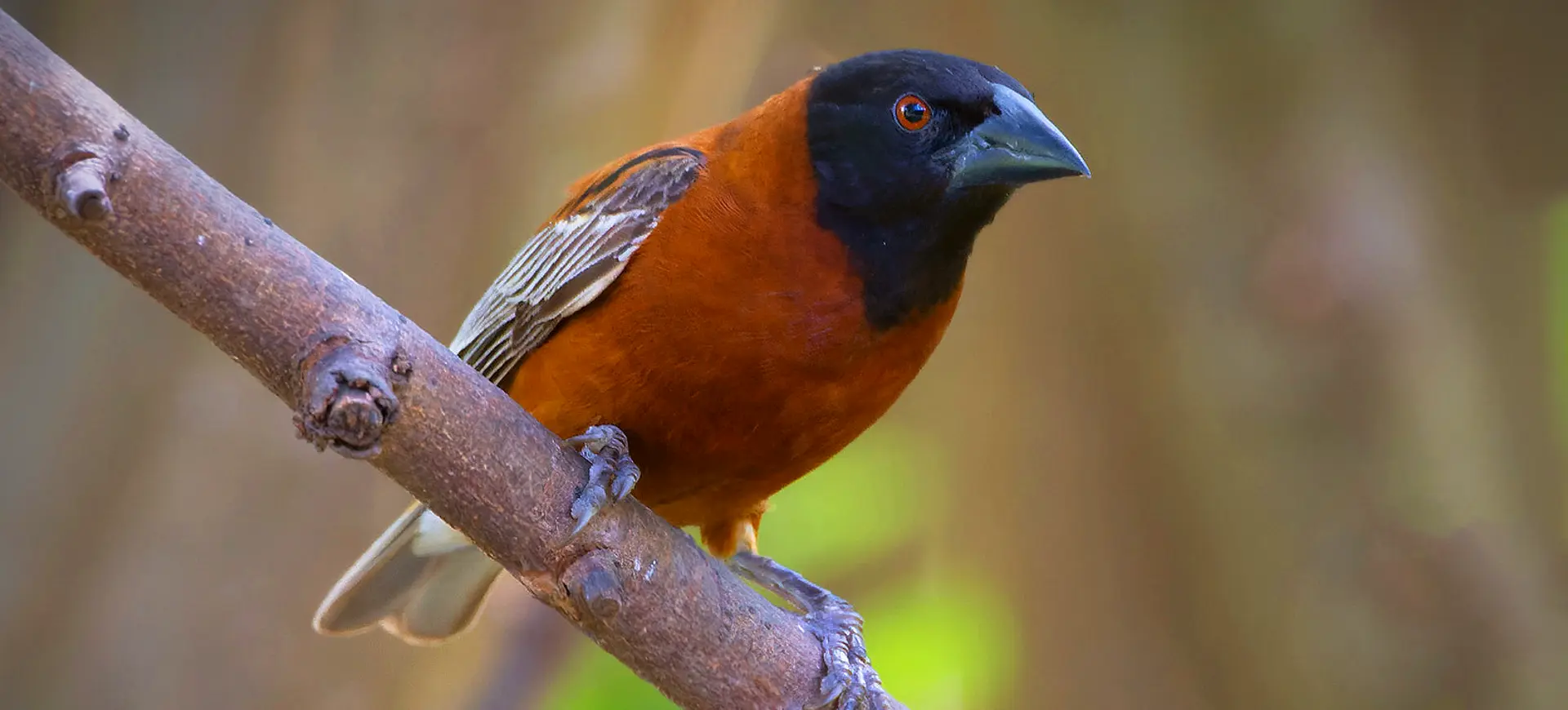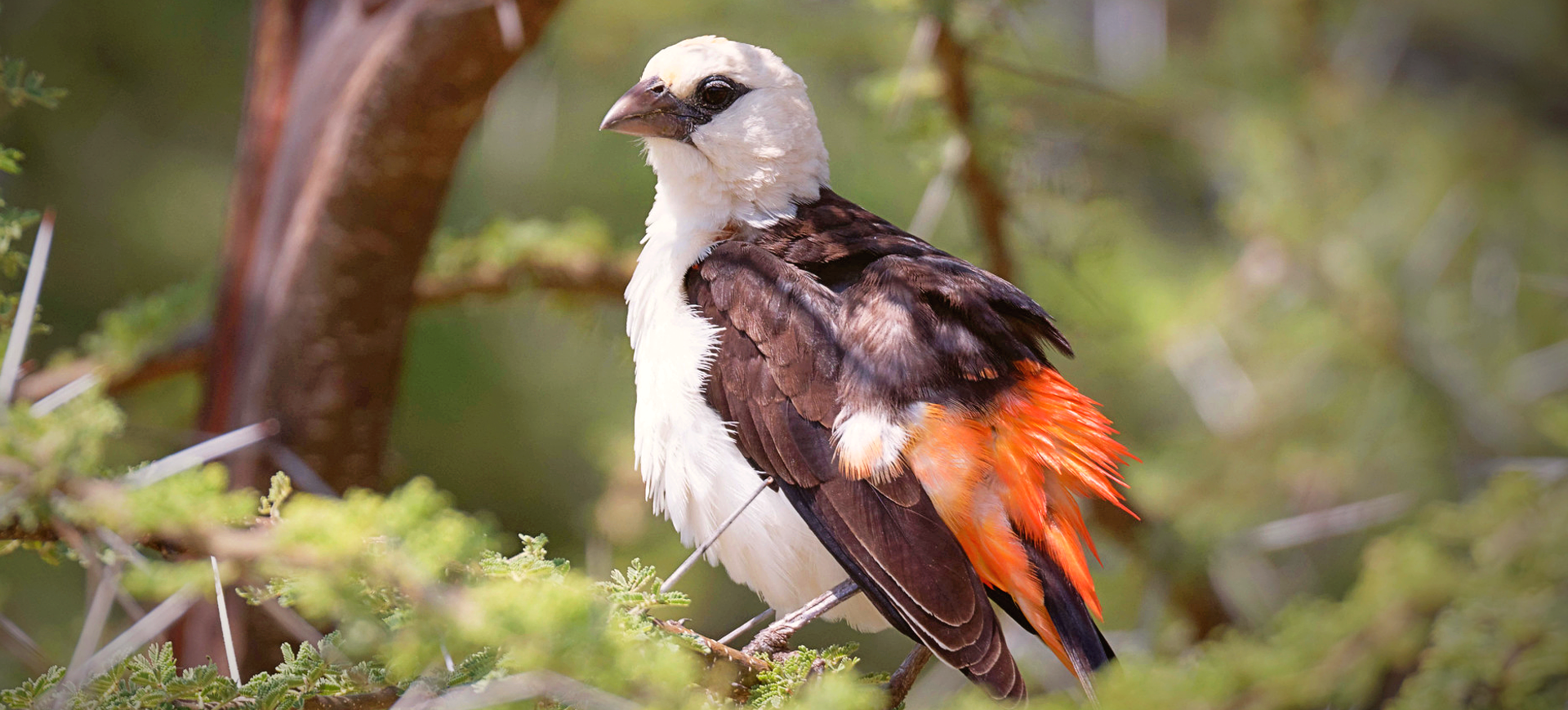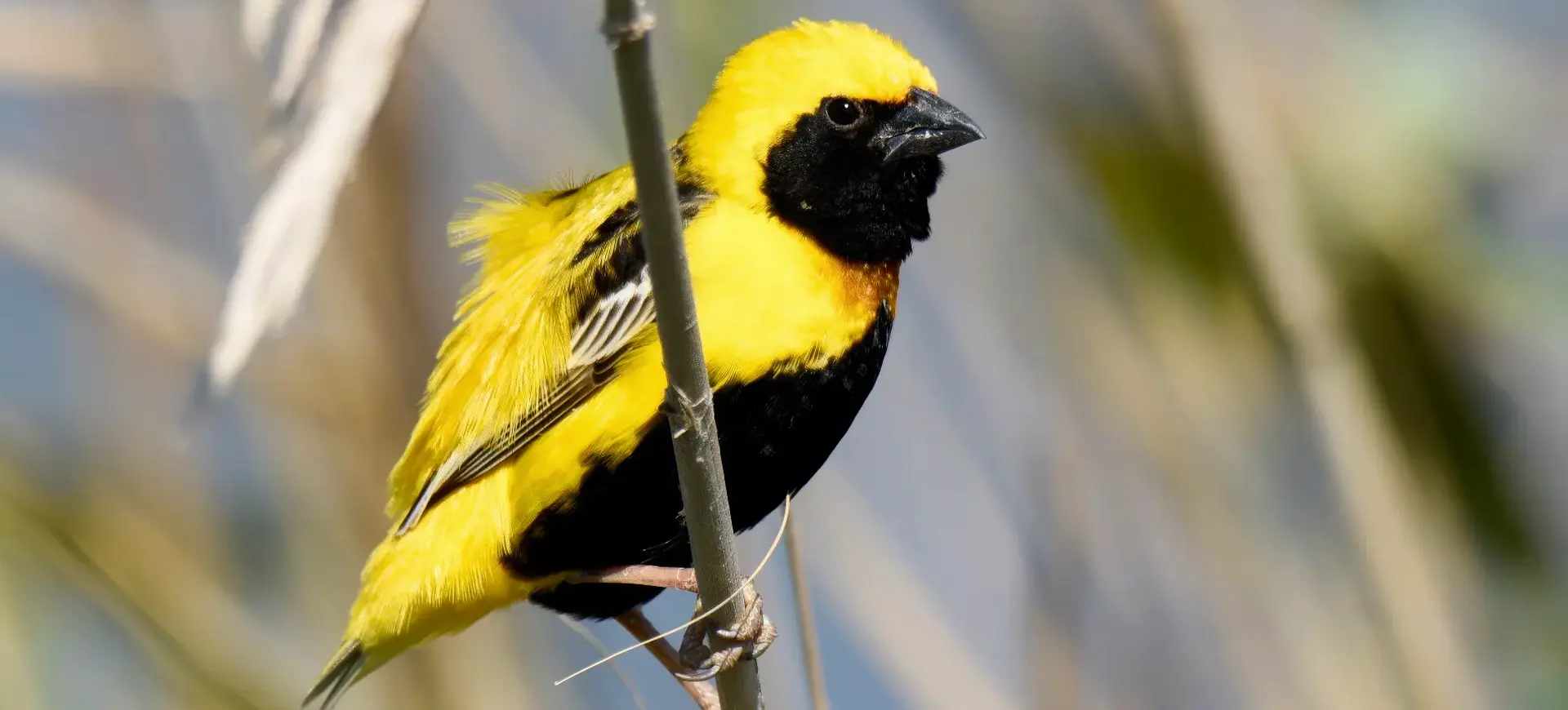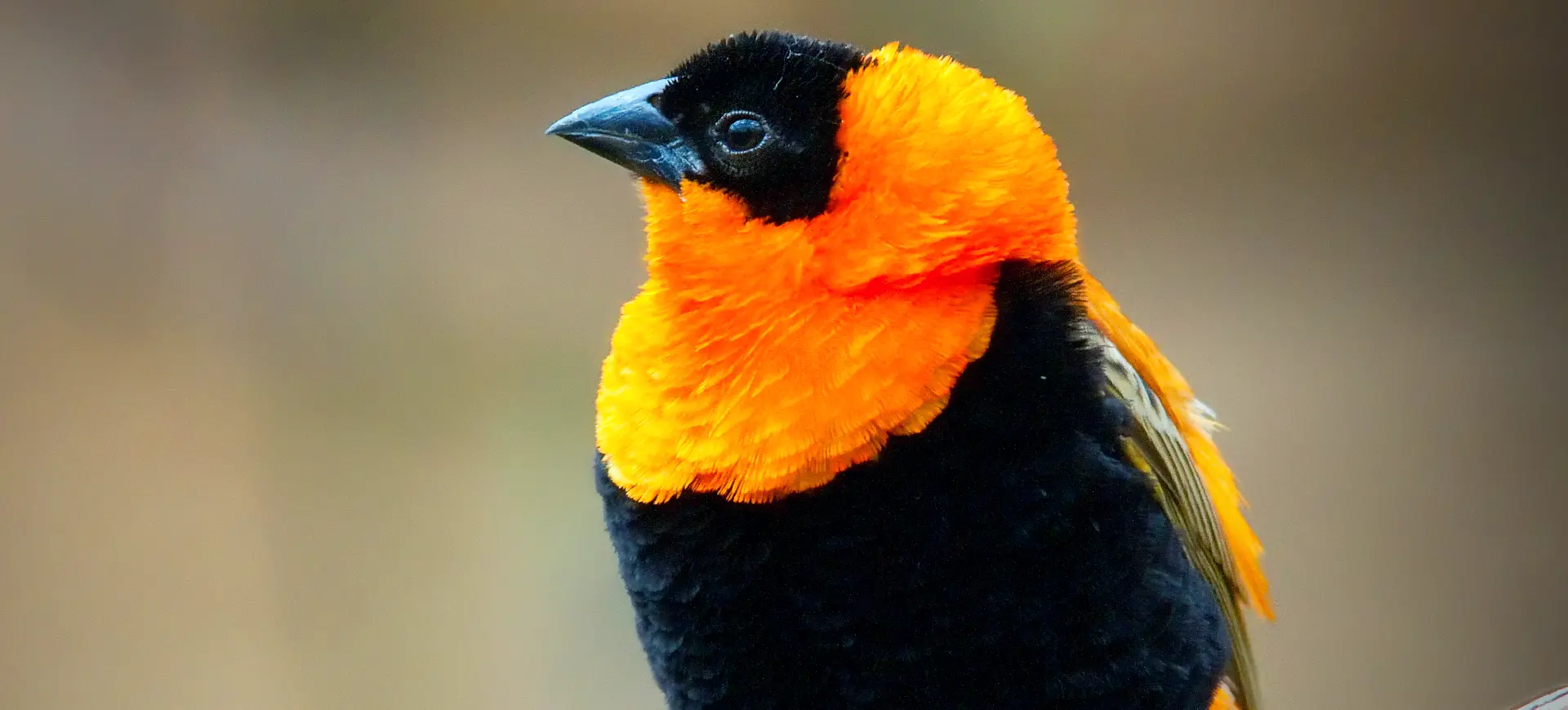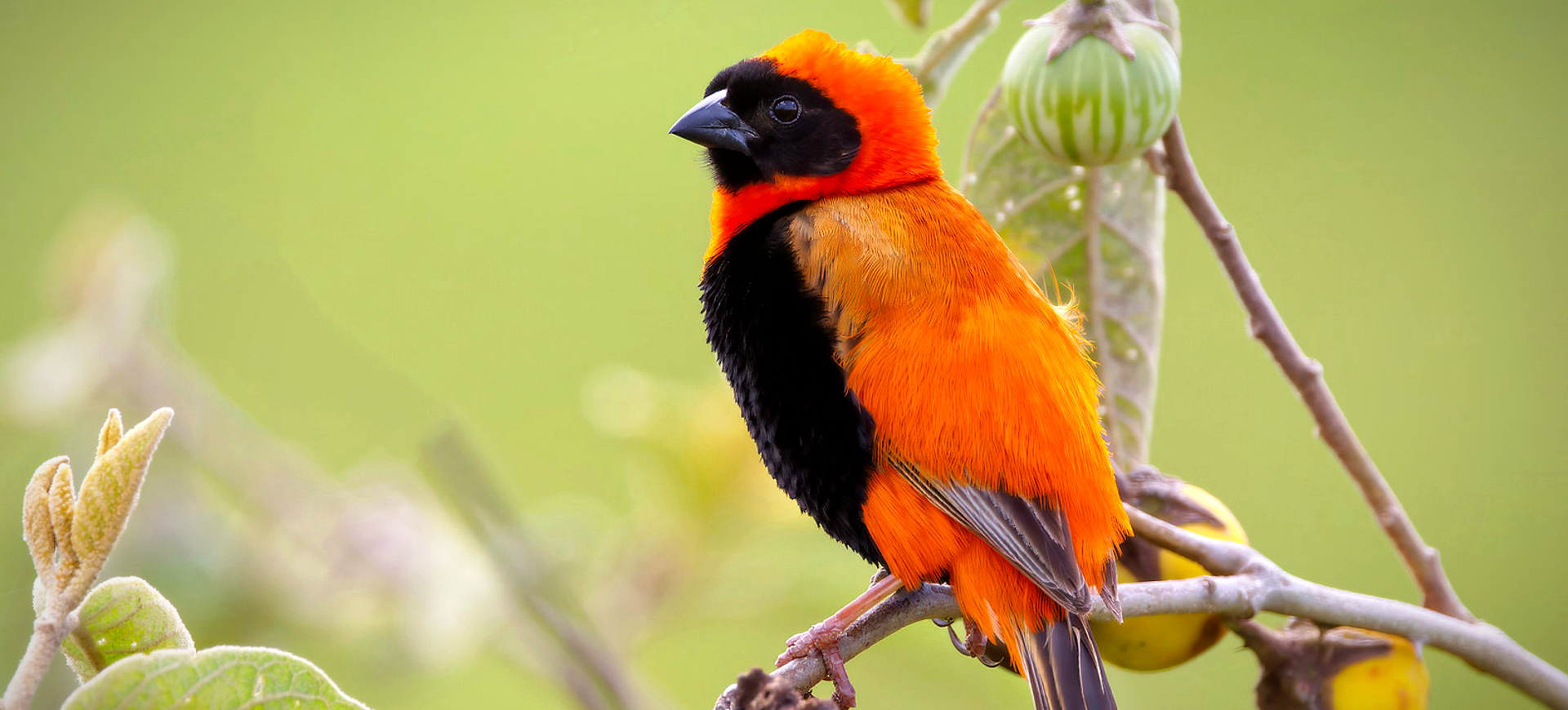Overview
The Taveta Weaver (Ploceus castaneiceps) is a strikingly colorful bird species native to the savannas and grasslands of Kenya and Tanzania. Recognized by its vibrant yellow and green plumage, the male Taveta Weaver showcases a bright golden body with a contrasting green back and tail, which becomes even more pronounced during the breeding season. Females and juveniles, on the other hand, display a more subdued coloration, primarily olive-green, allowing them to blend seamlessly into their natural habitat. This species is named after the Taveta area in Kenya, where it was first observed, and it thrives in reed beds and the edges of water bodies where it can find food and materials for nest building.
Its intricate and elaborate nesting behavior distinguishes the Taveta Weaver. Males are prolific builders, weaving complex, spherical nests out of grass and reeds suspended over water to protect against predators. These nests are a testament to the birds’ craftsmanship, with a small entrance hole meticulously constructed to prevent access by intruders. The social structure of Taveta Weavers revolves around their colonial nesting sites, where males display their nests to attract females. Once a female approves of the nest and the suitor, she will take up residence to lay her eggs, and the pair will work together to raise their offspring.
Conservation efforts for the Taveta Weaver focus on habitat preservation, as their wetland environments are threatened by agricultural expansion, pollution, and climate change. These birds play a crucial role in their ecosystems, serving as pollinators and seed dispersers that contribute to the health and regeneration of their habitats—protecting the wetlands and grasslands essential to the Taveta Weaver not only safeguards these vibrant birds but also supports biodiversity and ecological balance in East African savannas.
Taxonomy
Kingdom
Phylum
Class
Order
Family
Genus
Species
Type
Physical Description:
The Taveta Weaver is a small, brightly colored bird, with adult males featuring a distinctive golden-yellow body contrasting sharply with their olive-green back and tail feathers. The intensity of the males’ coloration signals fitness and attractiveness to potential mates, especially during the breeding season. Females and juveniles are less conspicuous, adorned in various shades of green that provide camouflage among the leaves and grasses of their environment. Both sexes have strong, conical beaks designed for their primarily seed-based diet, though they also consume insects.
The Taveta Weaver’s physical build is typical of the weaver family, with a robust body, short legs, and a rounded head. Its short and rounded wings enable quick, agile flight, essential for navigating dense vegetation and avoiding predators. The tail is short and squared, contributing to its balanced and controlled flight. Taveta Weavers are known for their beauty and remarkable nest-building skills, which require precision and strength to weave the intricate structures characteristic of the species.

Lifespan: Wild: ~7 years || Captivity: ~10 years

Weight: Male & Female: 0.85-1.06 oz (24-30g)

Length: Male & Female: 5-5.5 in (12.7-14 cm)

Wingspan: Male & Female: 5-6 in (13-15 cm)

Top Speed: Unknown
Characteristic:
Native Habitat:
The Taveta Weaver inhabits the savannas and grasslands of Kenya and Tanzania, with a particular affinity for areas near water bodies such as rivers, lakes, and swamps. These habitats provide the necessary resources for their survival, including materials for nest building and various food sources. The birds are particularly drawn to reed beds and papyrus swamps, where they construct their elaborate nests. The preservation of these wetland habitats is crucial for the survival of the Taveta Weaver, as they offer breeding and feeding grounds and protection from predators.
Adaptation to these environments is evident in the Taveta Weaver’s nesting and foraging behaviors. Selecting nesting sites over water reduces predation risk, while their social structure benefits from these wetlands’ abundant resources. Conservation of these habitats is essential, as they face threats from human activities such as agriculture, pollution, and urban development, which can lead to habitat degradation and loss.
Climate Zones:
Biomes:
Biogeographical Realms:
Continents:
Diet:
Diet & Feeding Habits:
Taveta Weavers are primarily granivorous, feeding on various seeds from grasses and grains, which they adeptly pick with their strong, conical beaks. Their diet is supplemented by insects, particularly during the breeding season, when the demand for protein increases to support egg development and chick growth. These birds are often observed foraging in flocks, taking advantage of the safety in numbers to protect against predators while feeding on the ground or in vegetation.
The feeding behavior of Taveta Weavers reflects their adaptation to the savanna and grassland habitats, where food resources can be seasonally abundant or scarce. During plenty, they may store seeds in crevices or soil, exhibiting a form of food caching that helps them survive leaner times. Their role as seed dispersers also benefits their ecosystem, contributing to the propagation of various plant species and maintaining habitat diversity.
Mating Behavior:
Mating Description:
Taveta Weavers exhibit a fascinating and complex breeding behavior, characterized by the males’ construction of elaborate nests to attract females. The breeding season is marked by intense activity, with males becoming more vibrant in color and engaging in displays to showcase their nest-building skills. Each male may construct multiple nests from grasses and reeds, weaving them into spherical shapes with a single entrance, demonstrating their craftsmanship and effort to entice a mate. These nests are often built in colonies, creating a bustling community of weavers working simultaneously to attract females.
Once a female selects a male based on the quality of his nest, she will inspect the structure thoroughly before committing. If satisfied, she will mate with the male, who then may assist in lining the nest interior with soft materials for the eggs. The female lays and incubates the eggs, while the male may guard the nest or begin the construction of another to attract additional mates. This polygynous mating system results in a dynamic and competitive breeding environment, with the success of males largely determined by their ability to construct and defend high-quality nests.
Reproduction Season:
Birth Type:
Pregnancy Duration:
Female Name:
Male Name:
Baby Name:
Social Structure Description:
Taveta Weavers exhibit a complex social structure centered around their breeding colonies, where individuals interact within a highly social and cooperative context. The colonies serve as focal points for mating, nesting, and raising young, fostering community among the weavers. Within these colonies, males compete for the attention of females through nest construction and displays, while females select mates based on the quality of their nests. This social dynamic plays a crucial role in the species’ reproductive success.
Outside of the breeding season, Taveta Weavers may form flocks that forage together, providing safety in numbers from predators. These flocks can include a mix of species, highlighting the interconnectedness of the savanna and wetland bird communities. The social interactions within and between species contribute to the complex web of relationships that define these ecosystems, emphasizing the importance of social behavior in the survival and reproduction of the Taveta Weaver.
Groups:
Conservation Status:
Population Trend:
The Taveta Weaver is currently listed as Least Concern by the IUCN, with a stable population trend. This status reflects the species’ resilience and adaptability to its environment despite facing potential habitat loss and degradation threats. The Taveta Weaver benefits from protecting wetland habitats within national parks and reserves, providing critical resources for survival and reproduction. Efforts to monitor the population and habitat conditions are important for early detection of any changes that could impact the species’ status.
Conservation initiatives that focus on wetland preservation and sustainable land use practices contribute to the stability of Taveta Weaver populations. These efforts are essential for ensuring the long-term health of the ecosystems they inhabit, supporting the Taveta Weaver and a diverse array of flora and fauna dependent on these environments. Community involvement in conservation and habitat restoration projects plays a key role in the success of these initiatives, fostering a collective commitment to protecting these vibrant birds and their habitats.
Population Threats:
The primary threats to the Taveta Weaver include habitat destruction and degradation due to agricultural expansion, pollution, and climate change. These threats can lead to the loss of wetland areas critical for nesting and foraging, impacting the species’ ability to reproduce and sustain its population. Additionally, pesticide use in agriculture can affect the availability of food sources, posing a risk to the health and survival of Taveta Weavers and other wildlife.
Efforts to mitigate these threats involve habitat conservation and management strategies that focus on protecting and restoring wetland ecosystems. Raising awareness about the importance of these habitats for biodiversity and human well-being is crucial for garnering support for conservation measures. Sustainable land use practices and policies that balance development needs with environmental conservation are essential for preserving Taveta Weaver populations and their natural habitats.
Conservation Efforts:
Conservation efforts for the Taveta Weaver focus on habitat protection and restoration, emphasizing conserving wetland ecosystems vital to the species. Initiatives include the designation of protected areas, the implementation of sustainable agriculture practices, and community-based conservation programs that engage local populations in the stewardship of natural resources. Educational campaigns raising awareness about the ecological value of wetlands and the species they support are also a key component of conservation strategies.
Collaborative efforts between conservation organizations, governments, and local communities are crucial for effectively managing wetland habitats. Research and monitoring programs provide valuable data on the status of Taveta Weaver populations and the health of their ecosystems, guiding conservation actions and policy decisions. By prioritizing the preservation of wetland habitats, these efforts contribute to the resilience of Taveta Weaver populations and the overall biodiversity of their regions.
Additional Resources:
Fun Facts
- Taveta Weavers are named after the Taveta area in Kenya, highlighting their regional significance.
- Males can weave up to five nests in a single breeding season, showcasing their remarkable craftsmanship.
- The vibrant yellow and green plumage makes it one of the most visually striking birds in its habitat.
- Taveta Weavers play a critical role in their ecosystems as seed dispersers and pollinators, contributing to habitat health.
- The intricate nests of the Taveta Weaver are considered architectural marvels in the bird world.
- These weavers have a unique ability to adapt their diet based on seasonal availability, showcasing their versatility.
- Conservation efforts for the Taveta Weaver also benefit numerous other species that share their wetland habitats.
- The social and cooperative breeding system of the Taveta Weaver is a subject of interest for ornithologists and bird watchers alike.
- Despite their small size, Taveta Weavers are known for their loud and melodic songs, adding to the auditory landscape of their environments.
- Protecting Taveta Weaver habitats supports the conservation of East Africa’s rich biodiversity and ecological balance.



